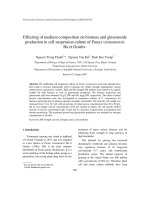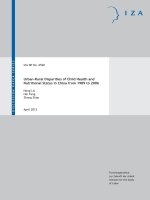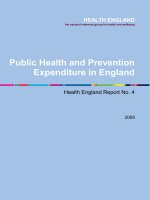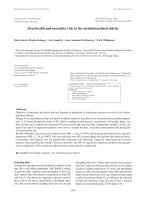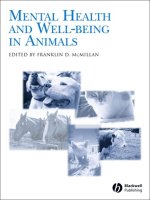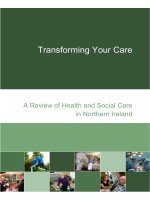underlying influences on health and mortality trends in post-industrial regions of europe
Bạn đang xem bản rút gọn của tài liệu. Xem và tải ngay bản đầy đủ của tài liệu tại đây (5.45 MB, 443 trang )
Glasgow Theses Service
Daniels, Gordon A. (2014) Underlying influences on health and mortality
trends in post-industrial regions of Europe. PhD thesis.
Copyright and moral rights for this thesis are retained by the author
A copy can be downloaded for personal non-commercial research or
study, without prior permission or charge
This thesis cannot be reproduced or quoted extensively from without first
obtaining permission in writing from the Author
The content must not be changed in any way or sold commercially in any
format or medium without the formal permission of the Author
When referring to this work, full bibliographic details including the
author, title, awarding institution and date of the thesis must be given
Underlying influences on health and mortality
trends in post-industrial regions of Europe
Gordon A Daniels: BA, MSc
Submitted in fulfilment of the requirements for the Degree of PhD
University of Glasgow College of Medical, Veterinary and Life Sciences, Institute
of Health and Wellbeing, Public Health research group
2014
2
Abstract
This Thesis is part of a wider programme of work being pursued by the Glasgow
Centre for Population Health (GCPH) which is examining health outcomes in
West Central Scotland and other post-industrial regions throughout Europe.
Background
Scotland‘s health has been improving since the industrial revolution but its
position relative to improving trends within Europe has been deteriorating. This
is recent, dating from the period since the Second World War and becoming
more problematical over the past three decades. While deprivation is a
fundamental determinant of health, in the case of Scotland (and particularly
West Central Scotland (WCS)) it does not explain the entire extent of the higher
levels of mortality. There is, of course, a well established link between
deindustrialisation, deprivation and poor health. However, the unexplained
additional mortality in Scotland and WCS (the Scottish Effect) compared to other
similar post-industrial regions and the time scale of Scotland‘s worsening
relative health status, require further investigation. Other research has
examined this question using a range of well established public health principles
and methods. This thesis adds to this understanding by providing a comparative
analysis of the political and socioeconomic contexts for the observed mortality
trends.
Setting
Post-industrial change is discussed at three levels. These are (i) International
regions – Eastern Europe and Western Europe (ii) Countries – Scotland within the
UK is compared with two Eastern European (Poland and the Czech Republic) and
two Western European (France and Germany) countries. (iii) Regions within
countries that have been subject to deindustrialisation. Five post-industrial
regions are investigated (West Central Scotland, The Ruhr, Germany, Nord Pas-
de-Calais, France, Katowice, Poland and Northern Moravia, Czech Republic).
These regions were selected because they are analogous in their experience of
deindustrialisation but diverse in their political and socioeconomic histories.
3
Methods
The main aim of the thesis is to determine what aspects of the political and
socioeconomic context in WCS have diverged from comparable post-industrial
regions of Europe and whether these might form the basis of potential
explanations for the region‘s poor health record. Two methods were employed.
First, a detailed narrative literature review was undertaken to examine political
and socioeconomic change in the post-war period at the national level with a
particular focus on policy responses to deindustrialisation. Second, case studies
were conducted on the five regions listed above. These examined political and
socioeconomic changes in each of the five regions in some detail using published
data and a variety of literatures as source materials. In this way a rich but
diverse picture of economic restructuring as a response to deindustrialisation
emerged. Insights from the literature review and case studies were then brought
together to formulate some conclusions about why health in WCS has suffered
more adverse effects than in the other four regions.
Findings
This thesis has shown that there was a broad correspondence between life
expectancy and the socioeconomic/political success of states in Central East
Europe and Western Europe during the 20
th
Century. When states prosper and
their governments enjoy the confidence of the population, health improves. In
all the countries covered in this analysis, deindustrialisation damaged health and
slowed improvements in life expectancy (in some cases putting it into reverse).
The institutional path dependencies and country-specific factors outlined in this
thesis help to explain the divergence in policy responses and subsequent
economic development that can be observed in each of the five regions and their
parent countries. The five countries and regions have each taken a different
approach to deindustrialisation, have varied in the levels of social protection
provided and each manifests a very different context. In response to economic
restructuring (and associated social costs), policy in WCS (and the UK) has
focused primarily on narrow economic growth policies, emphasising employment
and physical regeneration, but not social outcomes such as community cohesion
and sustainability.
4
Conclusions
Detailed comparisons suggest that WCS negotiated deindustrialisation less
successfully than the other regions. However, it is important to note that the
other regions are not ‗better‘ than WCS on all factors: there is a complex picture
to be understood in each region. Rather, what seems to emerge is that there are
a series of national and regional factors at work in WCS which have made the
aftershock of deindustrialisation particularly severe and may have contributed to
poorer health outcomes.
5
Table of Contents
Underlying influences on health trends in post-industrial regions of Europe. 17
1. Introduction 17
1.1 The Aftershock of Deindustrialisation 20
1.1.1 How this work differs and what it adds to GCPH? 27
1.2 The determinants of health in populations 28
1.3 Aim and objectives 34
1.4 The structure of the thesis 36
2. Methods 37
2.1 Overview of methods 37
2.2 Rationale for methods 39
2.3 Literature review 40
2.4 Case studies 48
2.5 Final synthesis 54
3. Synthesis of the narrative literature review 56
3.1 CEE 56
3.2 Western Europe 65
3.3 Conclusion 75
3.4 A simple framework for further analysis 77
3.5 Comparable data for the five post-industrial regions 78
3.6 Proxy geographies 78
3.6.1 Silesia/Katowice 79
3.7 Case study structure 80
4. The Ruhrgebiet (Ruhr region), 93
4.1 Deindustrialisation 94
4.1.1 Federal role 96
4.1.2 Regional role 97
4.1.3 Unemployment 104
4.1.4 Employment rates 105
4.1.5 Worklessness 107
4.2 Context 108
4.2.1 Skills and Education 108
4.2.2 Social exclusion 110
4.2.3 Social capital 114
4.2.4 Relative poverty 115
4.2.5 Income inequality 117
4.3 Social protection 118
5. Nord-Pas-de-Calais (NPdC) 120
5.1 Deindustrialisation 122
5.1.1 National response 123
5.1.2 Regional response 124
5.1.3 Unemployment 132
5.1.4 Employment rates 133
5.1.5 Worklessness 134
5.2 Context 134
5.2.1 Skills and Education 135
5.2.2 Social context 137
5.2.3 Social capital 142
5.2.4 Income inequality 143
5.3 Social protection 144
6. Katowice (Upper Silesia) 146
6.1 Deindustrialisation 148
6
6.1.1 National response 151
6.1.2 Regional response 152
6.1.3 Unemployment 157
6.1.4 Employment rates 158
6.1.5 Worklessness 160
6.2 Context 161
6.2.1 Skills and education 163
6.2.2 Social context 164
6.2.3 Social capital 170
6.2.4 Income inequality 172
6.3 Social protection 173
7. Northern Moravia (Moravia-Silesia) 177
7.1 Deindustrialisation 179
7.1.1 Restructuring 181
7.1.2 Political and policy responses 185
7.1.3 Unemployment 189
7.1.4 Employment rates 191
7.1.5 Worklessness 192
7.2 Context 193
7.2.1 Skills and education 195
7.2.2 Social context 196
7.2.3 Social capital 200
7.2.4 Relative poverty 201
7.2.5 Income inequality 202
7.3 Social protection 203
8. West Central Scotland (WCS) 206
8.1 Deindustrialisation 206
8.1.1 National responses 207
8.1.2 Regional dimension 211
8.1.3 Unemployment 216
8.1.4 Employment rates 216
8.1.5 Worklessness 218
8.2 Context 218
8.2.1 Skills and Education 222
8.2.2 Social context 224
8.2.3 Social capital 230
8.2.4 Relative poverty 230
8.2.5 Income inequality 231
8.3 Social protection 231
9. Discussion 234
9.1 Main findings 234
9.1.1 Summary tables 250
9.2 Have the research aims been achieved? 259
9.3 Political decisions have consequences for health – the example of
inequalities. 262
9.4 Theoretical consideration 265
9.5 Strengths and limitations 270
9.6 Conclusions 273
9.7 Recommendations 275
9.8 Concluding remarks/reflections 278
Appendix A……………………………………………………………………………………………………….…280
Appendix B………………………………………………………………………………………………………….376
Bibliography……………………………………………………………………………………………………… 386
7
List of Tables
Table 2.1: Strengths and Limitations of Systematic and Narrative-Literature
review
Table 3.1: Post-industrial European regions: country, size, industrial
specialisation and employment loss
Table 9.1: Characteristics of post-war economic models (1945-1980)
Table 9.2: Industrial development of selected regions
Table 9.3: Timing and speed of deindustrialisation and national responses
Table 9.4: Level of social protection from the state at time of deindustrialisation
and privatisation
Table 9.5: Regional responses to deindustrialisation
Table 9.6: Current economic models i.e. three varieties of capitalism
Table 9.7: Current levels and type of social protection
Table 9.8: Summary wider determinants of health
Table A.1: Social expenditure, 1960-1975, as percentage of GDP in the UK, West
Germany and France
8
List of Figures
Figure 1.1: West Central Scotland Region
Figure 1.2: Male life expectancy for WSC and ten post-industrial regions
Figure 1.3: Mortality of working aged men in WCS with European comparators
Figure 1.4: Impact of alcohol in WCS among 15 to 44 years old males
Figure 1.5: Evans & Stoddart (1990) Model of the Determinants of Health
Figure 2.1: Percentage of industrial employment lost in regions selected
Figure 3.1: Industrial employment as percentage of civilian labour force for five
host countries: 1956-2010
Figure 3.2: Unemployment as a percentage of civilian labour force for five host
countries: 1956-2010
Figure 3.3: Unemployed as a percentage of economically active population in
host countries for years: 2008 and 2011
Figure 3.4: Percentage of men aged 25-49 not in employment in selected
regions: 2001
Figure 3.5: At risk of poverty rates for working age adults not in employment in
host countries: 1995-210
Figure 3.6: Income inequality over time in Scotland and host countries: 1984-
2004
Figure 3.7: Percentage of adults aged 25-64 with tertiary level qualifications in
selected regions: 2008
Figure 3.8: Percentage of adults aged 25-64 with no or low-level qualifications in
selected regions: 2008
Figure 3.9: Percentage of households with children headed by a lone parent in
the selected regions: 1999-2002
Figure 3.10: Change over-time in percentage of households with dependent
children in selected regions: 1990-2001
Figure 3.11: Percentage of households that are single person households in
selected regions: 1999-2002
Figure 3.12: Change over-time in percentage of single person households in
selected regions: 1990-2001
Figure 3.13: Percentage of adults aged between the ages of 25 and 64 who were
married in selected regions: 2001
9
Figure 3.14: Percentage of adults in selected regions who never attend religious
ceremonies except on special occasions: 2002-2008
Figure 3.15: Voter turnout percentage for national parliamentary elections in
selected regions: 2005-2007
Figure 3.16: Change over-time for percentage voter turnout in national
parliamentary elections in selected regions: 1990-2007
Figure 3.17: Percentage of adult male daily smokers in selected regions: 2002-
2010
Figure 3.18: Percentage of adult female daily smokers in selected regions: 2002-
2010
Figure 3.19: Percentage of adult population not drinking during last year in host
countries between 2003 and 2007
Figure 3.20: Percentage of adult population drinking daily in selected host
countries between 2003 and 2007
Figure 3.21: Percentage of births to mothers under the age of 20 in selected host
countries: 2005-6
Figure 3.22: Occupations of employed population for selected host countries:
2007
Figure 4.1 The Ruhr Region
Figure 4.2: Unemployment in SW Scotland and the Ruhr
Figure 4.3: Male employment in WCS and the Ruhr
Figure 4.4: Female employment in WCS and the Ruhr
Figure 4.5: Educational attainment in adults in WCS and The Ruhr
Figure 4.6: Excess alcohol consumption in Greater Glasgow and selected cities in
The Ruhr
Figure 4.7: Relative poverty in South Western Scotland and North-Rhine-
Westphalia
Figure 4.8: Income inequality in WCS and North-Rhine-Westphalia.
Figure 5.1: Nord-Pas-de-Calais Region
Figure 5.2: Unemployment in WCS and NPdC
10
Figure 5.3: Male employment in WCS and NPdC
Figure 5.4: Female employment WCS and NPdC.
Figure 5.5: Percentage of NEETs in WCS and NPdC
Figure 5.6: Frequency of male alcohol consumption Greater Glasgow and NPdC
Figure 5.7: Frequency of female alcohol consumption Greater Glasgow and NPdC
Figure 5.8: Relative poverty SW Scotland and NPdC
Figure 5.9: Income inequality in WCS and NPdC
Figure 6.1: Katowice region
Figure 6.2: Unemployment in SW Scotland and Silesia
Figure 6.3: Male employment in WCS and Silesia.
Figure 6.4: Female employment in WCS and Silesia
Figure 6.5: Number of working age adults in workless households: Strathclyde
and Silesia
Figure 6.6: Number of lone parent households with dependents: WCS and Silesia
Figure 6.7: Number of adult daily smokers in WCS and Silesia.
Figure 6.8: Frequency of alcohol consumption in Scotland and South Poland
Figure 6.9: Degree of alcohol consumption in Scotland and South Poland
Figure 6.10: Number of adults with no religious affiliation in WCS and Silesia
Figure 6.11: Relative poverty in SW Scotland and Silesia
Figure 6.12: Income inequality in WCS and Silesia
Figure 7.1: Northern Moravia region
Figure 7.2: Unemployment in SW Scotland and N.Moravia
Figure 7.3: Male employment WCS and N.Moravia
Figure 7.4: Female employment in WCS and N.Moravia
11
Figure 7.5: Level of economic activity WCS and N.Moravia
Figure 7.6: Percentage of adult smokers in Glasgow and Karvina/Havirov
Figure 7.7: Percentage of problem drinkers in Greater Glasgow and
Karvina/Havirov
Figure 7.8: Percentage of adults who are a member of a club or organisation in
Glasgow and Karvina/Havirov
Figure 7.9: Relative poverty in SW Scotland and N.Moravia
Figure A1: Male life expectancy at birth: Czech Republic, Poland, Russia and
Bulgaria
Figure A2: Female life expectancy at birth: Czech Republic, Poland, Russia and
Bulgaria
Figure A3: Life expectancy 1950-2005: Scotland, France, West Germany, Poland
and the Czech Republic
12
Acknowledgements
I would first like to express my sincerest gratitude to my supervisors: Phil Hanlon
and Carol Tannahill. They have constantly supported and encouraged me
throughout this process. Second, I would like to express my significant
appreciation to David Walsh and Martin Taulbut for their support and assistance
generally and specifically in relation to the data included in this thesis.
I would also like to thank colleagues in the Public Health Research group-
University of Glasgow College of Medical, Veterinary and Life Sciences and
Glasgow Centre for Population Health for their assistance and encouragement.
Last but not least, I am sincerely grateful to my family and friends for their
enduring support.
This project was funded by the Glasgow Centre for Population Health.
13
I, Gordon Arthur Daniels, confirm that the work presented in this thesis is my
own. Where information has been derived from other sources, I confirm that this
has been indicated in the thesis.
14
Abbreviations
CDF: The French national coal mining company
CEE: Central East Europe
CEEOL: The Central East European Online Library
CHD: Coronary Heart Disease
COMECON: The Council for Mutual Economic Assistance
CME: Coordinated market economies
CSG: General social contribution (France)
CVD: Cardio vascular disease
CVRP: Clyde Valley Regional Plan
DM: Deutsche Mark
DME: Dependent market economies
EMU: European Monetary Union
EPL: Employment protection legislation
ESC OKA: Economic and Social Council of Ostrava-Karvina Agglomeration
EU: European Union
FDI: Foreign Direct Investment
FSU: Former Soviet Union
GA: Glasgow Action
GAPP: Agency for the transformation of Enterprises
GARR: Agency for Regional Development of Upper Silesia
GCPH: Glasgow Centre for Population Health
GDP: Gross domestic product
15
GEAR: Glasgow Eastern Area Renewal
HBNPC: Houillères du Bassin du NPdC
HQP: High quality production
ILO: International Labour Organisation
IMF: International Monetary Fund
KITS: Knowledge-intensive-technical-services
LEC: Local Enterprise Companies
LME: Liberal market economies
NATO: North Atlantic Treaty Organisation
NEB: National Enterprise Board
NEET: Young people not in education or training
NGO: Non-governmental organisations
NRW: Nord Rhine Westphalia
NSR: New social risks
NIF: National Investment Funds
NPdC: Nord Pas-de-Calais
NVQ: National Vocational Qualification
OECD: Organisation for Economic Cooperation and Development
OKD: Ostrava-Karvina Coal Mines
OIR: Old industrial region
OPEC: Organization of the Petroleum Exporting Countries
PFI: Public finance initiatives
PHINS: Public Health Information Network for Scotland
16
RAG: Ruhrkohle AG (German)
RMI: National minimum income (France)
SDA: Scottish Development Agency
SEZ: Special economic zones
SME: Small and medium sized enterprises
SPD: Social Democratic Party (Germany)
SSCI: Social Science Citation Index
SWS: South West Scotland
TNC: Transnational Corporations
UCS: Upper Clyde Shipyards
UDNMS: Union for the Development of Northern Moravia and Silesia
VOC: Variety of Capitalism
RDA: Regional Development Agency (Czech Republic)
UN: United Nations
WHO: World Health Organisation
WCS: West Central Scotland
Chapter 1 17
Underlying influences on health trends in post-
industrial regions of Europe.
1. Introduction
This thesis seeks to better understand the health status of the people of West
Central Scotland (WCS) in the period following deindustrialisation. It will do so
by reviewing the political and socioeconomic history of WCS and comparable
regions of both Western and Eastern Europe, examining some key data trends for
these areas in more detail and setting these observations in the context of
theories which consider links between social and economic systems and health
outcomes.
The rationale for the selection of the specific regions is set out in methods
section 2.4.1. The four comparator regions selected are: Nord-Pas-de-Calais
(France); the Ruhr area (Germany); Katowice/Silesia (Poland); Northern Moravia
(Czech Republic). These regions all share an industrial legacy and generally have
experienced the most comparable levels of deindustrialisation (measured as the
decrease in industrial employment) as WCS in recent decades. In addition, each
operated within a distinct geopolitical region and (now)
capitalist/socioeconomic system and has been subject to neoliberal change –
acknowledged as an uneven process and experienced differently according to
national and regional contexts. An understanding of this process and the
divergence between these regions should provide explanatory potential for the
divergence in life expectancy between WCS and similar post-industrial regions.
Before outlining the main aim and objectives of this thesis and specific research
questions to be addressed, this chapter will first introduce the region of WCS
and the significance of post-industrial change and will set out some ideas on the
determinants of health.
Chapter 1 18
The region of WCS
1
is home to 2.2 million people who form approximately 43 per
cent of the total Scottish population (NRS 2011). It comprises the eleven local
authority areas shown in Figure 1.1. The centre of the region (historically,
economically and culturally) is the city of Glasgow and the adjoining Clydeside
conurbation which includes the towns along the lower course of the River Clyde
such as Paisley, Renfrew, Clydebank, Dumbarton, Port Glasgow, and Greenock.
Historically, the fortunes of WCS were very much aligned to those of the British
Empire with much of the region‘s wealth derived from trading imported goods
and processing raw materials such as sugar, cotton, and tobacco (Gibb 1983).
The development of heavy engineering in the 19
th
century, particularly of
locomotives and ships destined for markets in the Empire and beyond, led to the
formation of an industrial nexus around Clydeside supported by the steel and
coal producing industries of the wider region (Hume & Moss 1977).
Figure 1.1: West Central Scotland Region
1
WCS comprises the same eleven local authority areas used in the first Aftershock report
discussed later in this chapter: East Ayrshire, East Dunbartonshire, East Renfrewshire,
Glasgow City, Inverclyde, North Ayrshire, North Lanarkshire, Renfrewshire, South Ayrshire,
South Lanarkshire, and West Dunbartonshire.
Chapter 1 19
During this period, the pace of industrialisation was rapid and by the beginning
of the twentieth century, WCS had ―the biggest concentration of heavy industry
in Britain‖ (Foster 2001:417). The region‘s burgeoning industrial workforce was
augmented by the rural population of the Scottish highlands who were forced by
changes in land ownership and agricultural practices to settle elsewhere (Devine
1994). The second major source of migrant labour came from Irish immigrants
fleeing the Irish potato famine in particular, and rural poverty more generally
(Foster et al. 2011). These developments caused the city of Glasgow and its
hinterland to experience rapid population growth until around 1919. Thereafter,
the rate of growth slowed, peaking around the middle of the century before
moving into a decline that stabilised during the 1990s (Lever 1991:985).
During the period of population expansion in the second half of the 19
th
century,
industry in WCS enjoyed a competitive advantage and grew rapidly. However, by
as early as the 1920s, heavy industry in the region was in decline, mainly
because it was unable or unwilling to adapt to changing circumstances or
implement new technologies and practices (Kurth 1979; MacInnes 1995). To
some extent, the onset of the Second World War masked this decline as the
industries around the Clyde responded to the wartime imperative for increased
production. The result was that in the immediate post-war period Clydeside was
producing 20 per cent of the world‘s output in ships and this prominence was not
solely due to the interim dislocation of other suppliers. Steel production in the
region was also booming, largely due to the demand from shipbuilders (Foster
2003:58).
The demand created by World War II and subsequent post-war reconstruction led
to higher levels of industrial employment, reaching a peak in 1961 (when 51 per
cent of the total working population were employed in industry) (Census 1961).
However, the truth was more complex: the industrial decline evident in the
inter-war period had not been rectified. By the 1950s, WCS‘s competitive
advantage was effectively lost. This was due to a significant lack of
technological investment and modernisation, in part by the state but also
inherited from the large but indebted family firms that owned the most
important industries (Payne 1996). This was exacerbated by the renewal of
Chapter 1 20
heavy industries in the countries that had experienced damage to their industrial
infrastructure during the war.
The shipbuilding industry was particularly affected as it was still using
technology from the 1800s which was in the hands of a workforce characterised
by multiple, fractious unions (Strath 1987; Lorenz 1991; Bristow 2009). In short,
industry in WCS was becoming difficult to manage and extremely costly to
sustain: the result was a continuing reduction in its share of world markets
(Devine 2000).
By the 1990s, WCS had lost its historical specialisation in engineering and service
industries had begun to comprise the majority of the economic base (Foster
2003:60). However, services without a secure and innovative production base
tend to be technologically limited. Moreover, a solid manufacturing base is a
critical component in the sustained development of service activities (Capron &
Debande 1997). Only in the 1990s did employment begin to recover. However,
the recovery has not been without its problems and the region continues to face
a number of social and economic challenges (Paddison 1993; Dorling et al. 2008).
1.1 The Aftershock of Deindustrialisation
It is within this context of industrial change that Scotland came to be labelled by
the media the ‗sick man of Europe‘ (Leon et al. 2003; NY Times 2004). This label
is not without justification, as recent analyses have demonstrated that Scotland
has the highest levels of premature and working age mortality of any western
European country for both males and females (ScotPHO 2007; Whyte 2007). Post-
industrial decline and its many associated factors (in particular multiple
deprivation) are commonly referred to as the major underlying influences
contributing to Scotland‘s poor health profile (Carstairs & Morris 1989; Scottish
Council Foundation 1998; Scottish Office 1999). This is particularly true in
relation to WCS where Scotland‘s post-industrial decline has been most severe.
Chapter 1 21
It is this situation that contributed to the establishment of The Glasgow Centre
for Population Health
2
(GCPH) which has sought to develop a better
understanding of health and health inequalities with a particular focus on
Glasgow and WCS. Two recently published findings from the researchers linked
to GCPH have led to deeper debate about the role of deprivation as a single and
unproblematic explanation for the poor health profile in WCS. The first was a
paper by Hanlon et al. in 2005 entitled: ―Why is mortality higher in Scotland
than in England and Wales? Decreasing influence of socioeconomic deprivation
between 1981 and 2001 supports the existence of a ‗Scottish Effect‘‖. This
paper reinforced the centrality of deprivation as the single most important cause
of ill health in WCS. However, it also established that Scotland had an excess
mortality above that which could be accounted for by standard measures of
deprivation, such as the Carstairs Index
3
. Deprivation accounted for much of
Scotland‘s excess mortality but the proportion of excess deaths that could be
attributed to deprivation was much less than had been the case in the 1980s.
The additional mortality beyond that which could be explained by deprivation
was called the ‗Scottish Effect‘. It is important to note the ‗Scottish Effect‘ has
an impact across all social strata and throughout Scotland. However, it is most
evident in Glasgow and WCS (Hanlon et al. 2005).
A second paper The Aftershock of Deindustrialisation: Trends in mortality in
Scotland and other parts of post-industrial Europe (Walsh et al. 2008, 2009
4
)
examined the same issue (Scotland‘s high levels of mortality and the role of
deprivation linked to deindustrialisation) from a different perspective. It
identified other European regions that had experienced collapses of industrial
employment and explored what impacts these had on their health trends.
2
The Glasgow Centre for Population Health (GCPH) was established in 2004 as a resource to
generate insights and evidence, to create new solutions and provide leadership for action to
improve health and tackle inequality.
3
Developed by Carstairs and Morris (1991), the Index of Deprivation is applied in spatial
epidemiology to identify socioeconomic confounding. Developed for Scotland it was an
alternative to the Townsend Index of Deprivation to avoid the use of households as denominators
(Elliot, 1997). The Index is based on four census indicators: low social class, lack of car
ownership, overcrowding and male unemployment. Areas are then split by postcode using these
variables.
4
Regarding The Aftershock of Deindustrialisation, there is both a detailed report (Walsh et al.
2008) and academic paper (Walsh et al. 2009).
Chapter 1 22
The Aftershock report presented three types of trends for a set of
deindustrialised European and UK regions: overall mortality trends, age and sex-
specific mortality trends and cause specific mortality trends. In terms of overall
mortality, the report found that male (see Figure 1.2) and female life
expectancy for WCS was improving more slowly than in almost every other
selected European region. As Figure 1.2 illustrates, WCS males at the end of the
period analysed (2003/05) had lower life expectancy than those from each of the
other regions except Katowice in Poland and Northern Moravia in the Czech
Republic. However, the rates of improvement in life expectancy in these two
regions compared to WCS suggested that these regions will overtake WCS if those
trends continued. WCS females (data not shown) also had lower life expectancy
than the other selected regions and improvement rates were also faster in the
comparator regions (Walsh et al. 2009).
It should be noted that infant and childhood mortality rates in WCS compared
reasonably well with rates recorded in the other regions. However, this was not
the case for the working aged populations.
Figure 1.2: Male life expectancy for WSC and ten post-industrial regions
Source: Taulbut et al. 2011
Chapter 1 23
In terms of age and sex-specific mortality, Figure 1.3 illustrates all-cause
standardised mortality rates for WCS males aged between 15 and 44 years
compared to the maximum, minimum and mean rates recorded in other regions
(including WCS itself). The findings here are as important as they are surprising.
In most cases WCS death rates were improving but at a lower rate than much of
the rest of the UK and Europe (that is, a relative decline). However, in younger
working-aged men, death rates in WCS had been increasing since the 1990s while
death rates in this age group in the other regions that have experienced a similar
industrial decline were decreasing
5
(Walsh et al. 2009). In short, for this age
group, WCS experienced an absolute as well as relative worsening relative to the
other regions.
Figure 1.3
6
: Mortality of working aged men in WCS with European comparators
Source: Walsh et al. 2009
5
The pattern for females, although less marked, is similar to the trend for males, with an
increase in rates from the mid-1990s onwards.
6
Selected European regions are: the Ruhr, Saxony, Katowice, Northern Moravia, Nord-Pas-de-
Calais, Wallonia, Limburg, Northern Ireland, Swansea and South Wales Coalfields and
Merseyside.
Chapter 1 24
Figure 1.4
7
: Impact of alcohol in WCS among 15 to 44 years old males
Source: Walsh et al. 2009
In terms of cause-specific mortality, there appeared to be a number of key
causes driving the increase in total WCS mortality rates in the 15 to 44 year age
group. Deaths from circulatory system diseases or all cancers were not higher in
WCS than in other regions for this younger working age group. These conditions
become important for older age groups.
Scotland‘s excess mortality in younger working aged males was primarily due to
deaths from suicide, violence, drug use and chronic liver disease due to alcohol.
Figure 1.4 illustrates dramatically the impact of alcohol in WCS among 15 to 44
years old males where, over the past 25 years, there has been a marked increase
in mortality from chronic liver disease due to alcoholic cirrhosis. The trend for
females was similar but less dramatic and in both instances WCS‘s relative
position had shifted from being significantly below the regional average in the
earlier years of the analysis to being the highest of all the post-industrial regions
analysed (Walsh et al. 2009).
7
See above.
